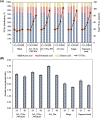Evaluation of in vitro digestibility of Aspergillus oryzae fungal biomass grown on organic residue derived-VFAs as a promising ruminant feed supplement
- PMID: 37777808
- PMCID: PMC10543868
- DOI: 10.1186/s40104-023-00922-4
Evaluation of in vitro digestibility of Aspergillus oryzae fungal biomass grown on organic residue derived-VFAs as a promising ruminant feed supplement
Abstract
Background: As demand for high quality animal feed continues to raise, it becomes increasingly important to minimize the environmental impact of feed production. An appealing sustainable approach to provide feed fractions is to use organic residues from agro-food industry. In this regard, volatile fatty acids (VFAs) such as acetic, propionic and butyric acids, derived from bioconversion of organic residues can be used as precursors for production of microbial protein with ruminant feed inclusion potential. This study aims to investigate the in vitro digestibility of the Aspergillus oryzae edible fungal biomass cultivated on VFAs-derived from anaerobic digestion of residues. The produced fungal protein biomass, along with hay clover silage and rapeseed meal were subjected to various in vitro assays using two-stage Tilley and Terry (TT), gas, and bag methods to evaluate and compare its digestibility for application in ruminant feed.
Results: The produced fungal biomass contained a higher crude protein (CP) (41%-49%) and rather similar neutral detergent fiber (NDF) (41%-56%) compared to rapeseed meal. The rumen in vitro dry matter digestibility (IVDMD) of the fungal biomass in the TT method ranged from 82% to 88% (statistically similar to that of the gas method (72% to 85%)). The IVDMD of fungal biomass were up to 26% and 40% greater than that of hay clover silage and rapeseed meal, respectively. The type of substrate and bag method had pronounced effect on the fermentation products (ammonium-N (NH4+-N), total gas and VFAs). Fungal biomass digestion resulted in the highest release of NH4+-N (340-540 mg/L) and the ratio of acetate to propionate ratio (3.5) among subjected substrates.
Conclusion: The results indicate that gas method can be used as a reliable predictor for IVDMD as well as fermentation products. Furthermore, the high IVDMD and fermentation product observed for Aspergillus oryzae fungal biomass digestion, suggest that the supplementation of fungal biomass will contribute to improving the rumen digestion by providing necessary nitrogen and energy to the ruminant and microbiota.
Keywords: Aspergillus oryzae; Fungal biomass; In vitro dry matter digestibility; Ruminant feed; Volatile fatty acids.
© 2023. Chinese Association of Animal Science and Veterinary Medicine.
Conflict of interest statement
The authors declare that there is no conflict of interest.
Figures





References
-
- Oecd FAO. OECD-FAO agricultural outlook 2022–2031. 2022; 10.1787/f1b0b29c-en.
-
- Deconinck K. Making better policies for food systems. OECD Publishing. 2021; 10.1787/ddfba4de-en.
-
- Magnusson U. Sustainable global livestock development for food security and nutrition including roles for Sweden. Stockholm: Swedish FAO committee; 2016. https://www.regeringen.se/contentassets/d57810919afa49a8af8757c6094afa34....
-
- Bratosin BC, Darjan S, Vodnar DC. Single cell protein: A potential substitute in human and animal nutrition. Sustainability. 2021;13(16):9284. doi: 10.3390/su13169284. - DOI
-
- Ferreira JA, Varjani S, Taherzadeh MJ. A critical review on the ubiquitous role of filamentous fungi in pollution mitigation. Curr Pollut Rep. 2020;6(4):295–309. doi: 10.1007/s40726-020-00156-2. - DOI
LinkOut - more resources
Full Text Sources
Research Materials
Miscellaneous

